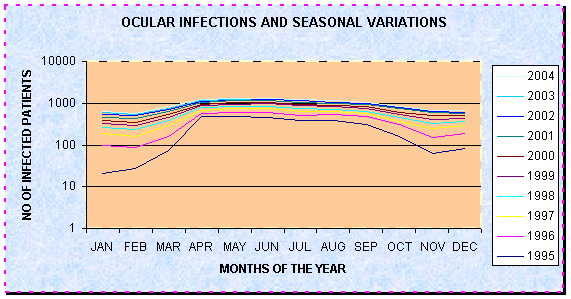|
Al-Shifa Journal of???????????
|
|||||||||||||||||||||||||||||||||||||||||||||||||||||||||||||||||||||||||||||||||||||||||||||||||||||||||||||||||||||||||||||||||||||||||||||||||
|
Aims and Scope
Ocular Infections and Seasonal Variations Sensitivity of Tests in Dry Eyes Intravitreal Kenacort in Macular Edema ERG in Diagnosis of Retinal Problems |
Ocular infections and seasonal variations Saadia Farooq, MBBS, MCPS, FCPS
Purpose: To study the relationship between seasonal variations and ocular infections, Study Design: Retrospective analysis of the patient record. Participants: ?10,322 patients with lab. documented ocular infections presenting at Al-Shifa Trust Eye Hospital between March 1995 to May 2004. Methods: The procedure to document ocular infections included conjunctival swabs, corneal swabs, A/C tap, vitreous tap etc. In all the cases obvious signs of ocular infection were there. Results: The number of patients presenting with ocular infections increased 8-10 times between March and September. Conclusion: There definitely exists a correlation between infections, including ocular infections and rise in temperature. Understanding the linkages between climatological and ecological change as determinants of disease will ultimately help in constructing predictive models to guide proactive prevention. Al-Shifa Journal of Ophthalmology 2005; 1: 17-20 © Al-Shifa Trust Eye Hospital, Rawalpindi, Pakistan. According to the United Nations Intergovernmental Panel on Climate Change,?greenhouse gas emissions are significantly accelerating current global surface warming .During this century the earth has warmed by about 0.5 °C, and the mid-range estimates of future temperature change and sea level rise are 2.0 °C and 49 cm, respectively, by 2100.1 If such changes occur, diseases that are influenced by weather factors may potentially respond to an altered climate regime. Extreme weather variability associated with climate change could add an important new stress to developing nations that are already vulnerable as a result of environmental degradation, resource depletion, overpopulation, or location (e.g., low-lying coastal deltas).This article will concentrate on whether eye infections increase during summer season or not. |
||||||||||||||||||||||||||||||||||||||||||||||||||||||||||||||||||||||||||||||||||||||||||||||||||||||||||||||||||||||||||||||||||||||||||||||||
|
Originally received: October 10, 2004
Materials and methods??????????????????????????????????????????????????????????????????? The procedure to document ocular infections included conjunctival swabs, corneal swabs, A/C tap, vitreous tap etc. In all the cases obvious signs of ocular infection were there. Results???????????????????????????????????????????????????????????????????????????????????????????? |
|||||||||||||||||||||||||||||||||||||||||||||||||||||||||||||||||||||||||||||||||||||||||||||||||||||||||||||||||||||||||||||||||||||||||||||||||
|
|||||||||||||||||||||||||||||||||||||||||||||||||||||||||||||||||||||||||||||||||||||||||||||||||||||||||||||||||||||||||||||||||||||||||||||||||
|
|
|||||||||||||||||||||||||||||||||||||||||||||||||||||||||||||||||||||||||||||||||||||||||||||||||||||||||||||||||||||||||||||||||||||||||||||||||
|
Discussion????????????????????????????????????????????????????????????????????????????????????????????????????????????????????????????????????????????? Results of this retrospective analysis shows that the infected patients coming to AL- Shifa spike during the hot months of the year. These include conjunctivitis, corneal abscess, endophthalmitis etc .There are four well-recognized physical consequences of climate change: (1) temperature rise, (2) sea level rise (3) extremes in the hydrologic cycle (4) accelerated ozone depletion. These four physical attributes of climate change are expected to increase the frequency of heat waves and possibly air pollution episodes thus increasing the potential health hazards2. Not only in ocular infections, the seasonal nature of systemic diseases incidence often can infer an association with weather factors. In sub-Saharan Africa, epidemics of meningococcal meningitis consistently erupt during the hot dry season and subside soon after the onset of the rainy season.3 ??????????? In Peru, prevalence of the diarrheal disease cyclospora peaks in summer and wanes during cooler winter months.5 Malaria is believed to be the most climate-sensitive vector-borne disease and thus most sensitive to climate change Other climate-sensitive diseases include mosquito-borne arboviruses, such as encephalitis, dengue fever, and Ross River virus. Field and lab studies on St. Louis encephalitis, 23 as well as lab studies on dengue virus, indicate that higher temperatures hasten viral development. In developing countries, water shortages cause disease through poor hygiene. In an eye study carried out in Qatar (Ref.) the broadest species spectrum (25–29 sp.) was recorded in the summer months May–August 1997 and the narrowest (11–12 sp.) in February and March 1998. The highest monthly wind velocity was regularly associated with higher fungal colony counts than in case of the lowest velocity. On the other hand, wind direction did not exhibit any regular correlation either with the colony counts of fungi or with the wind velocity. Diurnal fluctuations of fungal spores of fungi displayed one peak at 12 noon when the highest temperature and wind velocity, and the least relative humidity were recorded and one trough at midnight. ? |
|||||||||||||||||||||||||||||||||||||||||||||||||||||||||||||||||||||||||||||||||||||||||||||||||||||||||||||||||||||||||||||||||||||||||||||||||
|
Conclusion??????????????????????????????????????????????????????????????????????????????????????????????????????????????????????????????????????????? There definitely exists a correlation between infections, including ocular infections and rise in temperature. The results of the studies reviewed in this article must be viewed in the context of many other environmental and behavioral determinants. Future studies must consider, along with climatological factors, key variables such as poverty, sanitation, land use changes, and public health surveillance and mitigation program. Analyzing the role of climate in determining human health outcomes will require interdisciplinary cooperation among health scientists, climatologists, biologists, ecologists and social scientists ???????????? Understanding the linkages between climatological and ecological change as determinants of disease will ultimately help in constructing predictive models to guide proactive prevention.References??????????????????????????????????????????????????????????????????????????????????????????????????????????????????????????????????????????? ????? 1. Houghton, J.T.; Meira Filho, L.G.; Callander, B.A.; Harris, N.; Kattenberg, A.; Maskell, K., Eds.; "Climate Change, 1995–The Science of Climate Change: Contribution of Working Group I to the Second Assessment Report of the Intergovernmental Panel on Climate Change," Cambridge University Press: Cambridge, 1996. ? ????? 2. Shindell, D.T.; Rind, D.; Lonergan, P. "Increased polar stratospheric ozone losses and delayed eventual recovery owing to increasing greenhouse-gas concentrations," Nature 1998, 392, 589-592. ? 3.?? 3. Moore, P.S. "Meningococcal meningitis in sub-Saharan Africa: A model for the epidemic process," Clin Infect Dis 1992, 14, 515-525. ? 5.?? 4. Madico, G.; Checkley, W.; Gilman, R.H. "Epidemiology and treatment of Cyclospora cayetanenis infection in Peruvian children," Clin. Infect. Dis. 1997, 24, 977-981. ? 9.?? 5. Kalkstein, L.S.; Greene, J.S. "An evaluation of climate/mortality relationships in large U.S. cities and possible impacts of a climate change," Environ. Health Perspect. 1997, 105(1), 2-11. |
|||||||||||||||||||||||||||||||||||||||||||||||||||||||||||||||||||||||||||||||||||||||||||||||||||||||||||||||||||||||||||||||||||||||||||||||||


